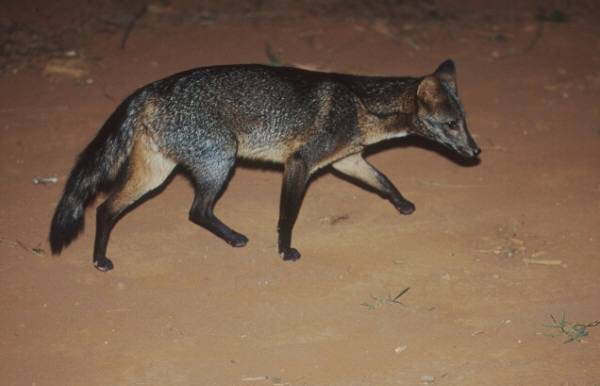Crab-eating Fox (Cerdocyon thous) - Wiki Crab-eating Fox
From Wikipedia, the free encyclopedia
[Photo] Cerdocyon thous. Date 2006. Author Alessio Marrucci
The crab-eating fox (Cerdocyon thous), also known as the crab-eating zorro, the wood fox, and the common fox, is a medium-sized canid found in the central part of South America. This fox is currently the only member of genus Cerdocyon, but an extinct species is known from the Pleistocene: Cerdocyon avius. This creature was probably similar to the crab-eating fox.
The crab-eating fox is predominantly greyish-brown with areas of red on the face and legs, and black-tipped ears and tail. It has short, strong legs and its tail is long and bushy. It may reach an adult weight of 10 to 17 pounds.
The crab-eating fox is a bush dog that ranges in savannas and woodlands, especially the llanos of South America. It is omnivorous, preferring insects or meat from rodents and birds when available. Other foods readily consumed include turtle eggs, carrion, and plants. As its name suggests, it often eats crabs and other crustaceans. During the wet season, the fox searches for crabs on muddy floodplains and then retreats to a den on higher ground, which may be no more than a large clump of grass. It is mainly nocturnal, emerging in the twilight.
The adult female gives birth to one or two litters per year, and the breeding pair is monogamous. The pair ranges the plains together.
This fox is occasionally hunted, but the fur is not valuable. The fox does not pose a danger to livestock. This is not currently a species of concern for conservation, however, its habitat is slowly shrinking due to human forces such as agriculture, as well as feral dogs' encroachment on its territory.
Subspecies
C. t. thous, Venezuela, Guyana, Surinam, French Guiana North Brasil.
C. t. azarae, North Brasil.
C. t. entrerianus, Brasil, Bolivia.Uruguay, Paraguay and Argentina.
C. t. aquilus, north Venezuela and Colombia.
C. t. germanus, Bogot?? region (Colombia).
http://en.wikipedia.org/wiki/Crab-eating_Fox
| The text in this page is based on the copyrighted Wikipedia article shown in above URL. It is used under the GNU Free Documentation License. You may redistribute it, verbatim or modified, providing that you comply with the terms of the GFDL. |
